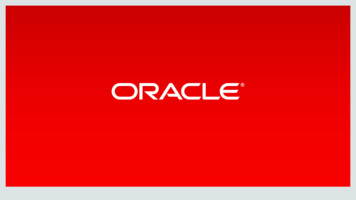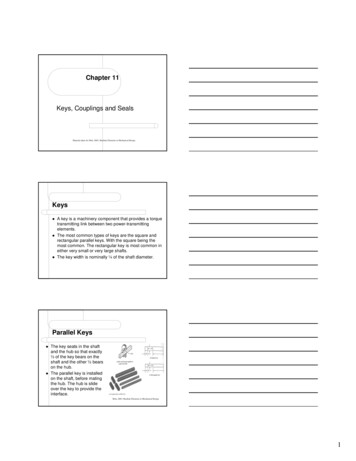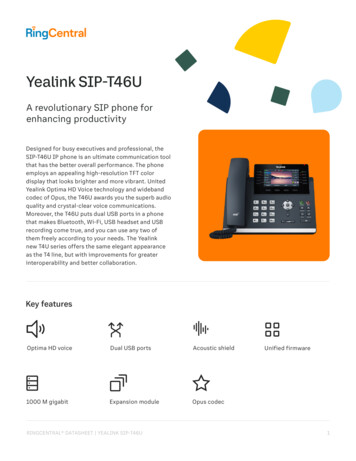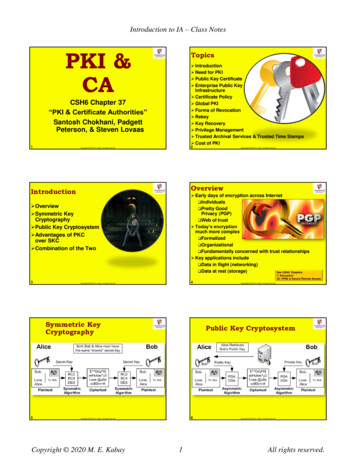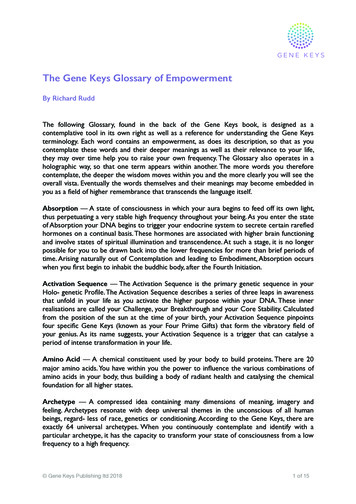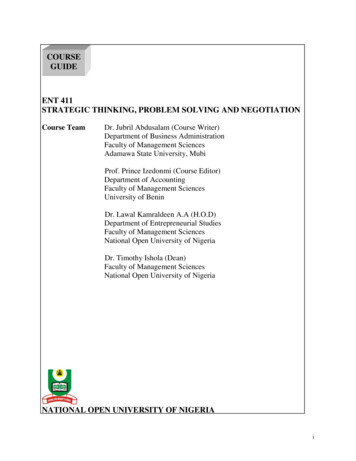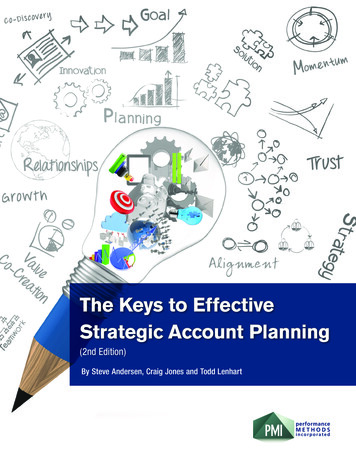
Transcription
The Keys to EffectiveStrategic Account Planning(2nd Edition)By Steve Andersen, Craig Jones and Todd Lenhart
Table of Contents: The Keys to Effective Strategic Account Planning (2nd Edition)Foreword iiiIntroduction ivAbout the Authors vChapter 1Benchmark and Assess the Account 6Chapter 2Engage and Align the Cross-Functional Account Team11Chapter 3Assess and Strengthen Customer Relationships16Chapter 4Co-Discover What the Customer Values Most21Chapter 5Align Objectives and Develop New Opportunities26Chapter 6Co-Create Value and Gain Momentum in the Account31Chapter 7Develop Customer Sponsors and Supporters36Chapter 8Build and Implement Account Growth Strategies41Chapter 9Measure the Impact of Account Plan Execution47Chapter 10Adapt to Meet the Customer’s Changing Needs54Chapter 11Engage the Customer in the Account Planning Process59Chapter 12Provide Coaching and Leadership to the Account Team64Acknowledgments 70 2020 Performance Methods, Inc.
ForewordFor more than 50 years, the Strategic Account Management Association (SAMA) has provided anenvironment for industry leaders from across the globe to share best practices and collaborate on topicscritical to becoming and remaining essential to their most important customers. SAMA member companiesare on the leading edge of innovation when it comes to customer-centricity, customer value co-creation,and developing and expanding trust-based relationships with customers. They pursue these objectivesthrough the design, development and deployment of strategic account planning and management solutions, best practices, skills and tools.In The Keys to Effective Strategic Account Planning (2nd Edition), authors Steve Andersen, CraigJones and Todd Lenhart of Performance Methods, Inc. (PMI) leverage their more than two decades of workwith SAMA and SAMA member companies to provide readers with a contemporary view of what greataccount planning and management looks like. The authors’ extensive experience working with organizations committed to strategic and key account management excellence forms the basis for this book, andthe flow of topics and examples engages readers in a journey rich with insights, practical takeaways andcommentary from acknowledged thought leaders and practitioners from across SAMA’s global community.If you’re looking for an explanation of how the most effective account managers in the SAMA communityof practice drive customer value co-creation and account growth, you need look no further than this book.The authors unpack the critical components of modern SAM/KAM programs and connect them into a storyof delivery that describes how top performers consistently drive successful growth with their customersthrough the execution of account planning and management best practices. In this updated and expandedsecond edition, PMI sets the standard for co-creating customer value, aligning cross-functional accountteams, building trust-based customer relationships and driving proactive account growth.I encourage you to invest in yourself by reading The Keys to Effective Strategic Account Planning(2nd Edition), and I look forward to seeing you at upcoming SAMA conferences, training workshops andlearning events.Denise FreierPresident and CEOThe Strategic Account Management AssociationiiiThe KeystoE f f e c t i v e S t r at e g i c A c c o u n t P l a n n i n g
IntroductionBy Steve AndersenPresident and FounderPerformance Methods, Inc.If you want to discover account management best prac-for facilitating and conducting effective account brief-tices at work, all you need to do is spend time in or aroundings and reviews, skills that are increasingly critical tothe Strategic Account Management Association (SAMA)sustaining implementations of account planning andand its member companies. Sharing best practices ismanagement. Also used by SAMA in the certification ofpart of the SAMA community culture, and there’s noaccount managers within the Certified Strategic Accountbetter place than SAMA to find examples of how globalManager (CSAM) program, this book introduces a power-industry leaders are achieving excellence in engaging andful approach for building a compelling “account story” ofco-creating value with their most important customers.customer success and mutual value co-creation.Over the past two decades, Performance Methods,Our deepest appreciation goes out to these organiza-Inc. (PMI) has worked with numerous organizations withintions for sharing their insights and best practices, and forthe SAMA community, and this work has provided oppor-participating in The Keys to Effective Strategic Accounttunities to witness firsthand how global industry leadersPlanning (2nd Edition): Allergan, Boehringer Ingelheim,manage and grow their most strategic customer relation-Hilton Worldwide, Honeywell International Inc., NetApp,ships. From these experiences, PMI has designed andPremier Inc., TÜV SÜD, Zoetis, and Zurich Insurancedeveloped our proven approach for implementing andGroup. Also, without the time, talent, and diligence ofsustaining SAM and KAM best practices: The Keys toSAMA and its outstanding team of professionals, thisEffective Strategic Account Planning (2nd Edition).book would not have been possible. Thanks to “TeamSAMA” for your support and contributions, as well.Many significant learnings are unpacked herein, withfocus on how to align your cross-functional account team,As you embark on your SAM/KAM journey, considerdevelop trust-based customer relationships, co-discoverselecting a customer important to your success this year.what your customer values most, and capture and lever-Focus on this organization and its stakeholders as youage past proven value. We’ll explore how to develop newthe concepts and bestproceed through the chapters— opportunities for value co-creation, how to build yourpractices will certainly be more relevant and practical ifaccount value portfolio with strategies to drive proactiveyou visualize application with a specific customer in mind.growth, how to measure the impact of account planIt has been our great pleasure to develop and enhanceexecution, and how to effectively engage your customer inThe Keys to Effective Strategic Account Planning (2ndthe account planning process.Edition), and we hope you enjoy reading this book asmuch as we have enjoyed researching and writing it.Finally, we’ll bring it all together with a proven processivThe KeystoE f f e c t i v e S t r at e g i c A c c o u n t P l a n n i n g
About the AuthorsSteve Andersen founded PMI following a suc-sales management, and account managementcessful 20-year technology career within the high-best practices. Steve also co-authored Beyondgrowth business applications software industry.the Sales Process: 12 Proven Strategies for aAs President and Founder, he is involved in clientCustomer-Driven World with Dave Stein in 2016.projects, solution development, and establishingSteve is a frequent speaker at SAMA confer-strategic direction for PMI.ences and academies, a member of the SAMASteve has served as “chief revenue officer”Certified Strategic Account Manager (CSAM) fac-Steve Andersenmultiple times during his career and his back-ulty, and a member of SAMA’s Board of Directors.President and Founderground includes extensive experience in sales,His client work has brought him into direct contactsales management, and sales leadership. He iswith many of the world’s largest corporations, andthe primary architect of PMI’s sales and accountmanagement methodologies, and he has numerous publications to his credit in the areas of sales,As PMI’s Managing Director, Craig uses hisexperience in sales, sales management, saleshe holds BS and MA degrees from the Universityof North Carolina at g materials, and consumer products.He has deep experience in the design, devel-coaching, and consulting to help organizationsopment, and delivery of PMI’s client solutions,win new business and grow existing relationshipsincluding executive-level positioning, manage-by institutionalizing best practices for their salesment coaching, strategic account management,and customer engagement teams. His extensivevalue selling, collaborative planning, and salesbackground includes the roles of sales executive,process design. Craig is credentialed throughCraig Jonessales manager, strategic account manager, andthe International Coach Federation (ICF) as aManaging Directoraccount executive.Professional Certified Coach. He is a frequentCraig’s client work includes experience withcontributor to the SAMA community and a mem-leaders from a variety of industries, such as manu-ber of the CSAM faculty. Craig holds a BS degreefacturing, information technology, life sciences,Todd LenhartManaging Partnerfrom the University of Florida.financial services, telecommunications, hospitality,cjones@performancemethods.comTodd Lenhart is a sales executive with over 25Prior to PMI, Todd served as President ofyears of experience in sales, sales management,Shapiro Negotiations Institute (SNI), a globalcorporate leadership, strategic planning, negotia-training and consulting firm focused on negotia-tions, and strategy execution. He brings a broadtion and influence. During his time with SNI, hebusiness background to PMI, with extensiveworked with a wide range of global companies,executive involvement working in and consultingincluding financial services, life sciences, mediawith large multinational corporations.and entertainment, energy, telecommunications,Todd’s corporate experience in sales and as aprofessional services, information technology, andCLO, coupled with his technical background asmanufacturing. Todd holds a bachelor’s degreea CPA, provide him with a unique perspective onfrom Penn State University, and is a member ofthe challenges facing sales leadership and theSAMA’s CSAM faculty.solutions that help leading companies optimizecustomer value co-creation.tlenhart@performancemethods.comvThe KeystoE f f e c t i v e S t r at e g i c A c c o u n t P l a n n i n g
Benchmark andassess the account
Chapter 1Benchmark and assess the accountThe Keys to Effective StrategicAccount PlanningBenchmark and assess the accountOur work with clients has taught us much about the importance1. Benchmark and assess the account2. E ngage and align the cross-functional accountteam3. Assess and strengthen customer relationships4. Co-discover what the customer values most5. Align objectives and develop newopportunities6. C o-create value and gain momentum in theaccount7. Develop customer sponsors and supportersof defining strategic/key accounts and communicating this effectively, both internally and with customers. Experience shows thatthe account selection process is typically ongoing and a criticalcomponent of any successful SAM program. At first glance, theaccounts and customer relationships most important to a supplier’s business may seem obvious, but closer inspection revealsthat the decision process can be challenging and even stressfulfor an organization. How does something that sounds so good forboth the supplier and the customer become so difficult?What makes a customer strategic?Among other factors, this depends in part on the customer’s8. Build and implement account growthstrategieswillingness to partner with the supplier, as most suppliers have9. Measure the impact of account plan executioncustomer relationships and deploy resources accordingly. Zurich10. A dapt to meet the customer’s changingneedsimplemented a successful SAM program led by the Commercial11. E ngage the customer in the account planningprocessassessing strategic accounts and strategic account performance12. Provide coaching and leadership to theaccount teamlimited resources and wish to focus on a select number of keyInsurance Group, an insurance-based financial services leader, hasInsurance business division. Zurich’s approach to defining andis considered to be a best practice.Ron Davis, Executive Vice President and Global Head ofCustomer Management, offers this perspective: “Our model of7The Keys to Effective Strategic Account Planning — Benchmark and assess the account
defining strategic accounts requires direct input from ourcustomer supporters and sponsors is one of the most criticalcustomers. In addition to potential strategic accounts meet-factors of SAM program success.ing pre-defined characteristics, our relationship leaders (i.e.,There’s an evolution occurring. Customer decision teamsstrategic account managers) speak with each customer inare expanding to include increasing numbers of influenc-advance to ensure there is mutual interest in establishing aers, recommenders, decision-makers, and sometimes evenstrategic relationship.”approvers. These types of individuals have vastly differentWe couldn’t agree more with this approach. Far too manydefinitions of value, depending on the person’s level within theso-called strategic customers don’t know they are strategic,organization, as well as their specific areas of responsibilitydon’t care that they are, or don’t understand what it means.(e.g., finance, marketing, engineering, quality, information tech-Davis goes on to add that “it is considered the relationshipnology, and human resources). The most effective strategicleader’s responsibility to conduct an ongoing assessment ofrelationships align the customer’s and supplier’s teams in aboth parties to determine whether they perform and executeway that offers connection points up, down, and across theas expected.” To support this, Zurich uses qualitative andcustomer’s organization. This alignment provides the founda-quantitative metrics.tion for an effective strategic relationship between the partiesin which each has a greater understanding and appreciation ofthe other’s needs, objectives, and success criteria.Strategic customer/non-strategic supplierWhat happens when a supplier considers a customer toIt’s not just about sizebe strategic to the supplier’s business, but the customerdoes not consider the supplier to be strategic to theirs? ThisIn the past, it was almost predictable that identifying adynamic, which is all too common, almost always results in astrategic account was a function of ranking customers by rev-lack of balance: the supplier inputs strategic resources andenue, then treating the top group as the most strategic. Evenvalue into the relationship, while the customer is focused ontoday, this kind of sorting is likely to be at the front end of mostreceiving tactical outputs (price, terms, and availability) fromattempts to define strategic accounts and customers. Butthe relationship. Because most suppliers, including industrythere is much more to a strategic relationship with a customerleaders, agree that there simply are not enough resourcesthan revenue, which becomes increasingly apparent whento serve every customer as though they are strategic, it isyou consider the success of specific strategic customer/critically important to select customers for SAM program par-supplier relationships PMI has observed within the SAMAticipation that are committed to this type of mutually beneficialcommunity. In other words, after you’ve defined and selectedrelationship.strategic customers, how do you measure the performanceand potential future value of these relationships? The mostUnfortunately, it’s not surprising to hear customers sayeffective SAM programs develop criteria for measuring thethings like, “I didn’t know we were a strategic account,” “Isuccess of the relationship, which they can use to assess thedon’t know what it means to be a strategic customer,” orstrategic fit with customers.even more disturbing, “Oh, good—what do we get for beingstrategic?” The ideal strategic customer/supplier relationshipStrategic impact zonesis authentic in nature, which means that each party wants theother to succeed, and both parties demonstrate this throughMany different methods can be used to determine strategictheir actions. You may ask “How can this be?” with the rise ofaccount fit and performance, and no one has an approach thatmore enabled and empowered procurement and supply chainwill work for every supplier and strategic account program. Asorganizations that seem increasingly driven to command thewith most things related to SAM/KAM, a supplier’s strategic“last dollar.” Supplier relationships with strategic customersaccount benchmark must be customized to the way that sup-must go far beyond the procurement organization, and forplier does business and should consider performance and themany organizations, developing deep and wide networks ofpast proven value of successful (and perhaps unsuccessful)8The Keys to Effective Strategic Account Planning — Benchmark and assess the account
strategic account relationships. There are strategicFigure 1. Account Planning Impact Zonesimpact zones that are useful in continually assessingstrategic account performance. While these zonesare not a substitute for SAM execution metrics (seeChapter 9: Measure the impact of account planALIGNMENTVALUEexecution), they provide a framework to benchmarkand assess strategic customer/supplier success. Value: There’s general agreement that co-creatingYou and YourStrategicAccount Teamsustainable and measurable business value with strategic customers is important, which leads to the question, “How do we know we are meeting and exceedingthe customer’s expectations of value from a strategicsupplier?” Value can be a function of many different variables, yet some of the more typical examplesinclude the availability of opportunities to collaborateand innovate with the customer, the opportunity forRELATIONSHIPSGROWTHthe customer and supplier to create mutual value bysharing best practices, and the supplier’s share of thecustomer’s spend on related products, solutions, andservices. Alignment: Alignment is about connection and fit, and it Growth: Growth has traditionally been defined in termsfocuses on where and how the supplier can best connect withof revenue and profits, but what are the factors that maya strategic customer and align objectives. Alignment consid-precede actual numerical growth? Strategic suppliers areerations may include the competitive position the supplier hasbeginning to look qualitatively beneath the numbers to uncoverdeveloped and achieved through experience with the customer,the actual sources of growth, and factors such as the degreethe fit of the supplier’s products, solutions, and services withof collaboration, mutual innovation, joint planning, and value co-the customer’s requirements, and the customer’s buying andcreation between the customer and supplier go a long way inpurchasing strategy and how well it fits with the supplier’s busi-determining future growth. The modern, trust-based customer/ness model. Equally important is the ability of the customer andsupplier relationship typically has at least one—if not all—ofsupplier to connect and achieve team-to-team alignment bythese dynamics at work.mapping supplier resources to the customer’s key stakeholders, a topic we will explore in greater depth later.Assessing strategic fit Relationships: Strong relationships are vital to achievingAfter you define “What is a strategic account?” within yourand maintaining effective strategic account performance, butorganization and help your customers understand what theythis goes far beyond how well the parties simply “like” eachstand to gain by participating, success is still not guaranteed.other. Challenging dynamics can emerge in strategic cus-Even the most effective strategic customer relationships aretomer/supplier relationships, and these may include the cus-subject to attack by competitive, economic, market, techno-tomer’s true willingness to partner (demonstrated by actions,logical, and regulatory pressures. The purpose of continuallynot words), the depth and breadth of trust-based relationshipsbenchmarking strategic accounts is to ensure that you receivewith key customer stakeholders, and the account manager/early warning indicators of non-performance, before mattersaccount team’s ability to develop sponsor and supporterbecome worse or it is too late to make corrections. To thisrelationships within the customer’s organization.end, the typical strategic account benchmark will have a mix9The Keys to Effective Strategic Account Planning — Benchmark and assess the account
of objective and subjective factors and, as many organizations are beginning to realize, performance factors that comedirectly from the customer.It can take years to develop a trust-based partnershipwith a customer, yet even the strongest relationships can bedamaged in an instant, sometimes for reasons beyond yourcontrol. Imagine the insight that can be developed and sharedwith account team members (and the customer) through theongoing assessment of the strategic relationship and analysisof change within the strategic impact zones: value, alignment,relationships, and growth. By considering an assessmentapproach that ranks ongoing effectiveness over time, youhave the opportunity to target areas of desired improvementand to focus your account planning process on addressingand prioritizing areas of the highest potential impact andgreatest importance to your strategic customer relationship.The upside to this type of approach seems clear, while thedownside of not benchmarking your accounts is likely to befraught with risks and surprises, which is not conducive toeffective strategic account planning and management.Conclusions and recommendationsToday’s most successful companies prioritize the needto become more strategic to their customers through thedeployment and implementation of effective SAM/KAM programs and best practices. In many cases, these programs arelaunched with a series of discussions about who the strategiccustomers are and how they contrast with one another. Beforemoving too far in the direction of the who and how, considerengaging in enterprise level collaboration about what makesa customer strategic to your organization. This will go a longway in reducing the number of selection/deselection activitiesyou’re likely to encounter downstream and help ensure thatyour SAM/KAM program is focused on the customers moststrategic to your business.10The Keys to Effective Strategic Account Planning — Benchmark and assess the account
Engage and alignthe cross-functionalaccount team
Chapter 2Engage and align thecross-functional account teamEngage and align the cross-functional accountteamThe Keys to Effective StrategicAccount PlanningOnce you’ve benchmarked your account and assessed thelevel of strategic fit that exists between your organization and thecustomer, the consideration becomes how you and your crossfunctional account team members can work together to become1. Benchmark and assess the account2. E ngage and align the cross-functionalaccount teameven more strategic to the customer. This may sound obvious and3. Assess and strengthen customer relationshipsnatural on the surface, but experience has proven that gaining a4. Co-discover what the customer values mostsense of balance and internal alignment with team members canbe a challenge—after all, their objectives and targets are oftendifferent than yours.Account team performance is enhanced when there is clarityregarding the role of each cross-functional team member, as wellas each member’s responsibilities in growing and evolving youroverall relationship with the customer to the next level of strategicfit. When sales, account management, and customer serviceefforts are harmonized, the results are always greater than those ofany single individual, regardless of role or position. Account teammembers work more effectively together in an environment that iscollaborative and synergistic, where there is a foundation of shar-5. Align objectives and develop newopportunities6. C o-create value and gain momentum in theaccount7. Develop customer sponsors and supporters8. Build and implement account growthstrategies9. Measure the impact of account plan execution10. A dapt to meet the customer’s changingneedsing, trust, and cooperation, rather than control, tension, and conflict.11. E ngage the customer in the account planningprocessTeam play vs. individual heroics12. Provide coaching and leadership to theaccount teamIn most business-to-business selling environments, the supplier’s12The Keys to Effective Strategic Account Planning — Engage and align the cross-functional account team
Figure 2. Aligning the Cross-Functional Account TeamAccountManagerLeadership andManagementRegionalSalespeopleSubject MatterExpertsYou and YourStrategic Account d R&DMarketing andProduct GroupsFinanceand LegalOther?sales or account team attempts to connect with a customer’sto continually save the day. In short, effective teamwork canbuying or decision team. Why is this alignment between thereduce the customer’s perception of risk and exposure, andsupplier’s team and the customer’s team so difficult for someprovide you, your account team, and your organization withorganizations? It usually begins with a lack of internal align-more balanced performance, particularly in the areas of valuement within the supplier’s cross-functional team members,co-creation and relationship expansion.which can result from ill-defined roles, conflicting goals, andaccount control issues, as well as other factors (including com-Working together as an aligned teampensation). When the account team is not aligned internally, itis difficult, and sometimes impossible, for team members toBefore a team can align effectively, it must be developedfocus as a synchronized unit on customer value co-creation.and structured so the team members understand “who doesThis typically does not go unnoticed by the customer.what” and how the sum of their talents and skills create aforce much stronger than that of any individual. Customer-When customers sense your account team is not aligned,facing teams are typically organized with specific objectivesthey become concerned about your organization’s abilityto set realistic expectations, execute on commitments, andin mind, including the pursuit of new sales opportunities, thedeliver results. A lack of effective teamwork invariably cre-development of long-term account relationships, the deliveryates situations where certain team members must perform atof solutions, and the co-creation of customer value. In eachhigher levels to meet customer needs, but individual heroicsof these, it is important to ensure that members of the cross-can be difficult to predict, forecast, and sustain. Most custom-functional account team understand their roles and “positionsers prefer to work with a functional and harmonized supplieron the field,” and how these relate to overall team performanceaccount team, rather than depending on a few top performersand success.13The Keys to Effective Strategic Account Planning — Engage and align the cross-functional account team
Resources and expertise are key factors in the creation ofsay that this delineation of resources within your account plancustomer-specific value (see Chapter 4: Co-discover whatcan be very helpful when it’s important to look at resourcethe customer values most), so when you’re selecting theprioritization and the application of team talent across multipleright people for your customer-facing team, it’s important tocustomers and accounts.consider fit and team-to-team alignment with the customer.Keep in mind that sometimes it’s better to build a team thatTeam leadership and directioncan take the field and perform effectively together, even if itCross-functional account teams that are well-aligned andmeans passing on certain “position players” that may be best-consistently co-create customer value tend to appreciate thein-class but not necessarily an effective fit with the rest of yourimportance of team leadership, including the role of the teamteam or with your customer.“quarterback.” It’s the same in sales and account managementas it is in sports: people respond to effective leadership, par-Core and extended account team membersticularly when the leader is personally invested in the team’sThink of your cross-functional account team as having twosuccess, able to demonstrate best practices, and willing totypes of members: “core” and “extended.” This delineationtake the time to understand other team members and what’scan be helpful as you align your team with your customer’simportant to each of them.team because it considers the level of commitment that theseAll too often, account teams find themselves in pressurizedtwo types of participants are likely to invest into the relation-situations without enough time to “do things right,” becauseship with the customer. Core team members are typicallyof customer requirements that result in tight timeframes andthose who engage with the customer on an ongoing, perhapsdifficult deadlines. In these cases, it’s especially important toeven daily basis, while extended team members have roleshave someone in a team leadership position who is ultimatelythat bring them into direct customer contact less frequentlycalling the plays. Account teams consistently benefit fromand only as needed for value co-creation and relationshipeffective “play calling” by the person in the role of team leaderexpansion purposes.or quarterback, particularly when it comes to matters of prioritization and resource deployment.Premier Inc. is a healthcare improvement company unitingan alliance of approximately 4,000 U.S. hospitals and healthThe team leader may not have all of the answers or evensystems and more than 175,000 other providers and organiza-be the ranking member of the team, but this individual’s roletions. Denise Juliano, Group Vice President of Life Sciences,is that of “chief
Hilton Worldwide, Honeywell International Inc., NetApp, Premier Inc., TÜV SÜD, Zoetis, and Zurich Insurance Group. Also, without the time, talent, and diligence of SAMA and its outstanding team of professionals, this book would not have been possible. Thanks to "Team SAMA" for your support and contributions, as well.



